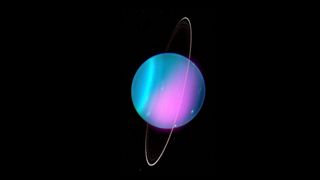Mysterious dust ring around Uranus spotted in rediscovered Voyager 2 data

Scientists have uncovered a new mystery about Uranus' rings buried deep in data from NASA's iconic Voyager 2 mission.
Voyager 2 flew past Uranus in January 1986, discovering 10 moons and two rings while becoming the first and so far only spacecraft to visit the ice giant. One of those rings, which scientists call the zeta ring, has frustrated astronomers ever since — they weren't even able to spot it again for nearly two decades. But last year, researchers got an unexpected gift: a new image of the Uranus' ring system, including the elusive zeta ring, courtesy of amateur image processor Ian Regan.
"For a long time we thought we only had two images of this ring from Voyager 2," Matthew Hedman, a planetary scientist at the University of Idaho, said during a presentation at the annual meeting of the American Astronomical Society's Division of Planetary Sciences on Oct. 5. "This shows there's a lot of information still encoded in the Voyager data that deserves a second look."
Related: Uranus by 2049: Here's why scientists want NASA to send a flagship mission to the strange planet
Scientists originally missed the find because the reddish dusty ring closest to Uranus wasn't visible in any individual image — Regan had to combine a host of images together for the feature to appear. "He took hundreds of images, stacked them together, to produce this image of the Uranian system," Hedman said. "This is the most comprehensive view of the zeta ring that exists and we didn't know it was in the Voyager data for decades."
The new image combined with the previous two Voyager photographs offered Hedman and his colleagues enough information to calculate the ring's distance from Uranus, about 23,000 miles (37,000 kilometers) above the planet, and to estimate its brightness.
But both of those values are puzzling. The Keck Observatory in Hawai'i had gathered the first observations of the zeta ring since Voyager 2 in 2007. These observations showed the ring at 25,000 miles (40,000 km) above the planet — a bit farther from Uranus than the Voyager 2 observations showed.
Get the Space.com Newsletter
Breaking space news, the latest updates on rocket launches, skywatching events and more!
"The trick is that the location of this ring didn't match the Voyager images," Hedman said of the Keck observations. "Something had changed about this ring over the course of 20 years. We're still not entirely sure what that was, though."
And the zeta ring didn't just inch away from the planet during those two decades it went unmonitored; it also registered a stronger signal in the Keck observations than it had in Voyager 2's view.
"It got significantly brighter, which means dust got introduced to the system sometime in those 20 years," Hedman said. "Now, what did that? We have no idea."
Hedman suggested that Uranus could have been hit by a space rock that fragmented into debris and settled in the zeta ring, or that perhaps the changing seasons could be responsible, but both are merely ideas. Whatever happened must have been dramatic enough to affect the rings, but also have slipped under scientists' radar.
NASA will begin planning a major mission to explore the Uranus system in the coming years, but scientists won't have data from that mission for a couple of decades. However, Hedman noted that the James Webb Space Telescope had captured a dazzling image of similar rings around Neptune, released in September.
"Fortunately, there is a telescope that seems to be very good at looking at dusty rings around planets," he said. "So that might be nice."
Email Meghan Bartels at mbartels@space.com or follow her on Twitter @meghanbartels. Follow us on Twitter @Spacedotcom and on Facebook.
Join our Space Forums to keep talking space on the latest missions, night sky and more! And if you have a news tip, correction or comment, let us know at: community@space.com.

Meghan is a senior writer at Space.com and has more than five years' experience as a science journalist based in New York City. She joined Space.com in July 2018, with previous writing published in outlets including Newsweek and Audubon. Meghan earned an MA in science journalism from New York University and a BA in classics from Georgetown University, and in her free time she enjoys reading and visiting museums. Follow her on Twitter at @meghanbartels.
